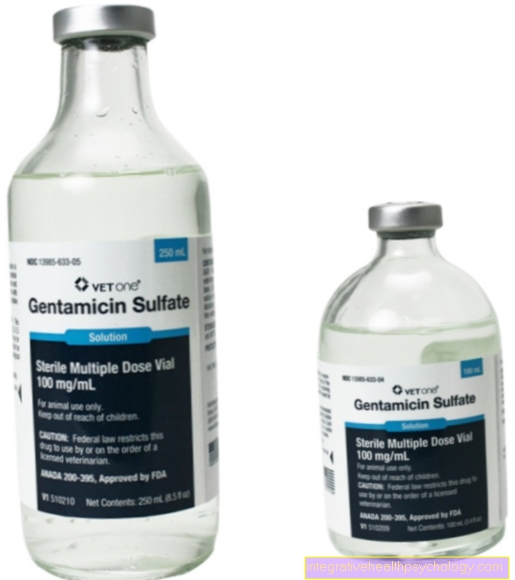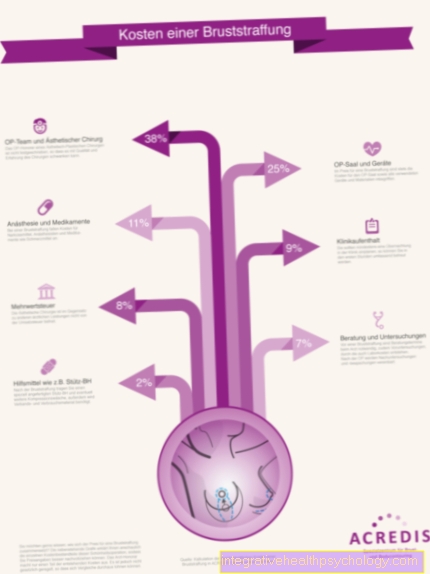Local anesthetics
definition
Local anesthetics are drugs used to give local anesthesia. They are called local narcotics, but must not be confused with the active substances called narcotics, which fall under the Narcotics Act and which include opioids. These are powerful and largely addictive pain relievers. Local anesthetics are used to inhibit the transmission of pain and are therefore used in numerous invasive procedures on the body.

At the dentist
Local anesthesia is often used in dentistry to be able to carry out outpatient interventions painlessly. A distinction is made between surface anesthesia, infiltration anesthesia, conduction anesthesia and intraligamentary anesthesia. In surface anesthesia, an anesthetic is applied to the mucous membrane. Infiltration anesthesia is more invasive because the local anesthetic is injected into the gums with a syringe. With conduction anesthesia, an entire nerve pathway and thus all of the nerves that originate from it are blocked and the goal of intraligamentary anesthesia is to numb a specific tooth.
In some cases, the affected area of the mucous membrane is superficially anesthetized before the injection of the local anesthetic in order to reduce the pain of the puncture. This prevents the fear of injections or the fear of the dentist in general. There are also low-pain injection techniques. Before the medication is injected, the dentist checks that he has not accidentally stabbed a vessel by sucking in with the syringe (aspiration test). If so, a new syringe will have to be used, as injecting it into a blood vessel can cause cardiovascular problems.
Read more on this topic at: Local anesthesia at the dentist
Side effects
As mentioned above, local anesthetics also act on sodium channels in the heart and central nervous system, provided the dose is high enough. This can happen due to the choice of too high a dose or incorrect application. For example, by mistakenly putting the local anesthetic into a vein (intravenous) is injected. It can also happen that during epidural anesthesia the cannula is pushed too far and comes to rest in the subarachnoid space. Since the dose of the drug is higher for epidural anesthesia than for spinal anesthesia, this can also lead to serious side effects. This can lead to cardiac arrhythmias in the heart, in the worst case to cardiac arrest.
Local anesthetics lead to hyperexcitability in the central nervous system. For example, this may start with a tingling sensation around the mouth (perioral), slurred speech, restlessness, dizziness, tremor or nervousness and fear. The maximum form are convulsions, which can lead to respiratory failure. Furthermore, the use of a local anesthetic can lead to allergic reactions up to the maximum form, anaphylactic shock. The substances of the amide type that are used much more frequently nowadays, however, have hardly any allergenic potency, so that the risk of intolerance can be classified as rather low.
Read more on the topic: Local anesthesia side effects
Local anesthetics in pregnancy
Local anesthetics are usually used for smaller, outpatient procedures, examples of which are biopsies or dental procedures. Since only a small amount of the drug is applied locally, the chance of systemic effects is low and therefore an effect of the local anesthetic on the baby is unlikely. A 1977 study with lidocaine also showed no increased rate of malformations. Local anesthetics can therefore also be used during pregnancy.
Read more on this topic at: Local anesthetics in pregnancy
Duration
The duration of local anesthesia depends on the anesthetic used. Both the onset of action and the duration of action can vary between the drugs. The effects of lidocaine last for one to two hours, but that of bupivacaine can last up to 5 hours. It is best to ask the doctor before the procedure how long the local anesthetic can be expected to work for.
Contraindications / Contraindications
There are relatively few contraindications for the local application of local anesthetics, since the drugs usually hardly develop any systemic effect with this type of application. Important contraindications for the use of local anesthetics are already known allergies to the active ingredient, inflammation in the area of application, since effectiveness there is not certain, and an increased tendency to bleed, for example due to treatment with blood thinners (anticoagulants).
However, this does not have to do with the drugs themselves, but with their application and is especially true for anesthesia procedures close to the spinal cord, such as spinal or epidural anesthesia, since bleeding can cause great damage when the cannula is inserted. Pregnancy and breastfeeding are not a general contraindication, but the indication should be made strictly. The use of local anesthetics in young children should only be used in urgent cases. Even with severe cardiac arrhythmias and heart failure, the application should be carefully considered.
allergy
An allergy to a local anesthetic can lead to various symptoms.On the one hand, rather harmless local reactions such as redness, itching or rash can occur, on the other hand severe systemic reactions such as a drop in blood pressure or anaphylactic shock, which represent a life-threatening situation. However, such severe reactions are very rare. Skin tests can be used to determine whether there is an allergy to a certain medication and, accordingly, to consider other local anesthetics or other anesthetic methods.
Intolerances
Various symptoms can occur in the event of intolerance to a local anesthetic. Itching and redness often occur, so there is always a risk of allergy. In the case of an allergic reaction, severe systemic reactions can be expected in some cases, which can range from a drop in blood pressure to complete anaphylactic shock.
General, physiology and effect
The first local anesthetic used as such was cocaine in the 19th century. In contrast to the drugs in use today, however, cocaine is addictive. Nowadays it is only rarely used in medicine, especially for operations in otolaryngology, nose and throat medicine. Derivatives of cocaine have been developed over the years. There are two groups here. Such from Ester type, which include cocaine, procaine and tetracaine, and those dated Amide type. These include lidocaine, prilocaine and mepivacaine. They differ in their chemical and physiological properties.
All local anesthetics work by blocking voltage-dependent sodium channels. In the nociceptive system (i.e. the system of pain detection and transmission) this leads to a blockade of the transmission of the action potential. The pain is absorbed by receptors in the periphery - for example on the hand - but then blocked in its transmission to the central nervous system. This means that local anesthetics do not inhibit the registration or absorption of the pain stimulus, but rather its transmission. In this way, the perception of pain does not reach consciousness and the person concerned does not perceive any pain. The disadvantage of local anesthetics is that the sodium channels they block aren't unique to the nociceptive system. They are also found in the heart and the central nervous system. In the heart, by inhibiting the transmission of excitation, they can lead to cardiac arrhythmias and even cardiac arrest, and dangerous side effects can also occur in the central nervous system. Therefore, as the name suggests, the substances may only be used locally.
Please also read: Side effects of procaine or procaine syringe
If the dosage or application is incorrect, however, the local anesthetic may spread further in the body than intended, which can lead to complications. One tries to avoid this through several factors. On the one hand through the above-mentioned local application, which makes large-area distribution unlikely. On the other hand, through the use of substances that are unstable, that is, are quickly broken down and then lose their effectiveness. A third factor that avoids the unwanted distribution of the local anesthetic in the body is the addition of vasoconstrictor substances, i.e. drugs that constrict the blood vessels.
The applied local anesthetic arrives in the tissue, but due to the vasoconstriction of the surrounding vessels, it cannot diffuse away in large quantities from the point where its effect is desired. However, vasoconstrictor substances such as adrenaline or noradrenaline must not be used during surgery on the acres. These include fingers, toes and also the nose. Here the risk of a permanent undersupply of blood and thus of tissue death would be too great due to a vascular narrowing.
Lidocaine
Lidocaine, one of the local anesthetics of the amide type, is not only used for local anesthesia, but is also used as an antiarrhythmic. So it works against cardiac arrhythmias by interfering with the function of the sodium channel. This may sound paradoxical at first, since - as already mentioned above - local anesthetics can trigger cardiac arrhythmias; so does lidocaine. In this respect, it can be used for the therapy of arrhythmias in the heart, but its contradicting pro-arrhythmic potential must not be ignored.
Nerve fibers react differently to local anesthetics. The transmission of impulses is inhibited earlier in the thinner sensory fibers than in the thicker motor nerve fibers. This is the reason why the sensation of pain can be switched off with preserved motor function. The various sensitive qualities are also switched off at different speeds. So first the sensation of pain decreases, then the sensation of temperature and even later the sensation of touch and pressure. Patients who have been given a local anesthetic often notice the pressure of the scalpel or other instruments, but no longer feel any pain.
Due to their chemical properties, local anesthetics have a significantly reduced effectiveness when the pH value is too low (i.e. too acidic) or too high (i.e. too alkaline). This means that local anesthesia in inflamed tissue that has a lower pH value will be significantly worse or not at all effective. This must be considered before use.
Indication & application
Local anesthetics are used to inhibit pain. They are used for interventions on the body that cause pain and in which the patient is not anesthetized. During anesthesia, other substances are used to reduce pain. There are four types of local anesthesia. In surface anesthesia, the drug is applied to the (mucus) surface of the skin and diffuses from there to the sensitive nerve fibers. In infiltration anesthesia, the drug is usually injected into the tissue through a syringe and then spread over the desired area. With conduction anesthesia, the drug is injected close to the nerve root and thus the transmission of pain is inhibited.
Here will be peripheral and near the spinal cord Procedure differentiated. Peripheral procedures include brachial plexus anesthesia on the arm. Spinal anesthesia and epidural anesthesia (also known as epidural anesthesia) are among the procedures close to the spinal cord. In spinal anesthesia, a cannula is used to puncture the subarachnoid space in which the cerebral fluid (liquor) is to be found. This is where the spinal nerves lie with their anterior and posterior roots. The procedure for epidural anesthesia is similar, but the cannula is not advanced quite as far as for spinal anesthesia. The dura mater (hard meninges) is not pierced during epidural anesthesia, so that the drug approaches the spinal nerve to be anesthetized by diffusion.
The decisive difference between the two methods is that the drug is distributed in spinal anesthesia by gravity in the fluid-filled subarachnoid space much more widely than in epidural anesthesia in the connective and fatty tissue epidural space. For example, with spinal anesthesia in the lumbar spine, the entire lower half of the body is anesthetized, while with epidural anesthesia it is mainly the area into which the anesthetic was injected. The last procedure to be mentioned is intravenous local anesthesia, in which the drug is injected into the vein after a tourniquet has been applied.
On the eye
In ophthalmology, local anesthetics are administered on the one hand by syringe, e.g. during operations on the eyelid such as corrections or tumor removal. On the other hand, anesthetic eye drops are also used, especially for operations directly on the eyeball. They are also used for painful diseases such as corneal injuries. Another area of application is the measurement of intraocular pressure, since pressure is exerted directly on the cornea, the examination would not be possible without anesthetic eye drops.
As an ointment
Local anesthetics are also available in the form of ointments. Just like powders, gels and sprays that contain anesthetic substances, they are used for surface anesthesia. The ointment is applied to the desired area on the skin or mucous membrane. It is now absorbed and reaches the sensitive nerve endings, which are then numbed and therefore no longer pass on the pain sensation. Local anesthesia with ointments is usually used for minor operations on the skin or anus, e.g. for treating hemorrhoids, their use. An example of a local anesthetic ointment is lidocaine ointment, which is used in addition to procedures for tattoos or piercings. Contraindications for local anesthetics are an allergy to the active ingredient and large-scale use on already damaged skin. This increases the risk of an undesirable systemic effect, since more of the active ingredient can penetrate deeper into the tissue.
As a spray
Just like ointments, numbing sprays are also used for surface anesthesia. So you spray on the desired area and wait briefly for the local anesthetic to take effect. It numbs the sensitive nerve endings that are in the skin or mucous membrane. Sprays are often used on the lining of the mouth and throat, e.g. before endoscopic surgery or at the dentist. An example of a local anesthetic spray is the xylocaine spray.
Poisoning / intoxication
Since local anesthetics are usually applied locally in low concentrations, systemic effects and intoxication are rare. However, if a higher concentration enters the bloodstream, various symptoms of intoxication can occur, such as metallic taste in the mouth, numbness around the mouth, tinnitus, cramps, coma, etc. The heart can also be affected and cardiac arrhythmia up to and including circulatory failure can occur. The vital functions then apply e.g. secure by intubation.
dose
It is administered by means of a syringe, the drug is in various concentrations in ampoules. Lidocaine is an example: Up to 60 ml of lidocaine in a dose of 0.5% to 2 ml or 5 ml can be administered, whereby the lowest dose should always be aimed for. When selecting the (maximum) dose, the local anesthetic method used always plays a decisive role.
costs
Here are an example Lidocaine (Trade names: Xylocaine®, Licain®, Versatis ®, Trachisan ® and others), a widely used amide-type local anesthetic as well Mepivacaine, also belonging to the amide type: 10 ampoules of lidocaine in a dose of 0.5% / 2 ml cost about 15 euros. 5 ampoules of mepivacaine (trade names: Meaverin ®, Mecain ®, Scandicain ® and others) in a dose of 0.5% / 2 ml also cost 15 euros.





























